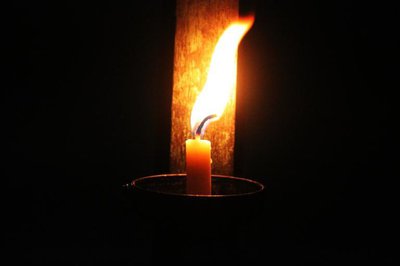Thoughts for the Day
Tuesday, 2nd February 2021: Candlemas
Mary Temple holy-lord Luke 2 Candlemas
Reading : Verses from Luke, Chapter 2
When the time came for their purification according to the law of Moses, they brought Jesus up to Jerusalem to present him to the Lord, (as it is written in the law of the Lord, 'Every firstborn male shall be designated as holy to the Lord'), and they offered a sacrifice according to what is stated in the law of the Lord, 'a pair of turtle-doves or two young pigeons'.
(Church in Wales Lectionary, New Revised Standard Version)
Thoughts

We had this reading recently (press "holy-lord" tag above) but today is a special day. It's Candlemas Day, and is traditionally the last feast day that refers to Christmas. From now on we move towards Easter. In the Orthodox Church, this is celebrated with an all-night vigil on the eve of the feast and a celebration of the Eucharist the next morning when beeswax candles are blessed, and it's because of this that it has come by its name "Candle Mass".
In the past church candles for the year ahead were blessed. When people had tallow candles or rush lights, the wax candles in church must have seemed amazing. We can only imagine what it was like to live in semi-darkness, and of how important light would have been.
There is a saying about this day:
- If Candlemas Day is clear and bright,
winter will have another bite.
If Candlemas Day brings cloud and rain,
winter is gone and will not come again.
The snowdrop is sometimes known as the ‘Candlemas Bell’, perhaps because of the purity of its flower in comparison with the purity of the Virgin Mary. The children of the Cathedral school in Gloucester normally hold a service and each child takes snowdrops into church.
But this is not just an ancient rite. It reminds us of a time when men and women asked God’s blessing on everything in their lives. How often do we thank God for the things He gives us – or are our prayers always “please do this” and “please do that?”
Prayer
Heavenly Father,
we thank You for light:
the light of the sun and moon,
and the light of Your Son, Jesus Christ.
We thank You for clean water,
for all the earth's natural resources.
We thank you for good friends
and for our family.
Help us never to forget all
that You give us this day.
Amen.
Here's some more information on Candlemas: Today, has a number of names:
- Candlemas Sunday
- The Feast of the Presentation of Jesus at the Temple
- The Feast of the Purification of the Virgin Mary
- The Meeting of the Lord.
On this day Mary and Joseph and the baby Jesus come to the Temple in Jerusalem, forty days after the baby’s birth at Bethlehem to complete Mary’s purification after childbirth. This day also remembers the time when the people of Israel were slaves in Egypt. God brought them out of Egypt saving them from Pharaoh, and allowing his Spirit to pass over the Hebrews. From then on all firstborn sons were offered to God, and redeemed or bought back, by making an offering of a bird or animal to God.
Candlemas was originally a minor celebration for Christians, but in 543 AD Justinian I who was Emperor changed it to a major feast day. In 541 there had been a terrible plague in Constantinople which had killed thousands of people. The Emperor, in consultation with the Patriarch of Constantinople, ordered a period of fasting and prayer throughout the whole of the Roman Empire. On this day great processions were organized to be held throughout the towns and villages of the entire Empire, and then a solemn service was held to ask God for deliverance from all evil. The plague subsequently ceased, and in thanksgiving, the feast was elevated to a more solemn celebration.
Candlemas even found its way into the secular calendar in past times – it became the traditional day to remove the cattle from the hay meadows, and from the field that was to be ploughed and sown that spring. Until 1991, indeed, it was still one of the Scottish quarter days, at which debts are paid and the law courts are in session.
Oh yes, and it is probably the root of the story that is celebrated as Ground Hog Day in the US. See: